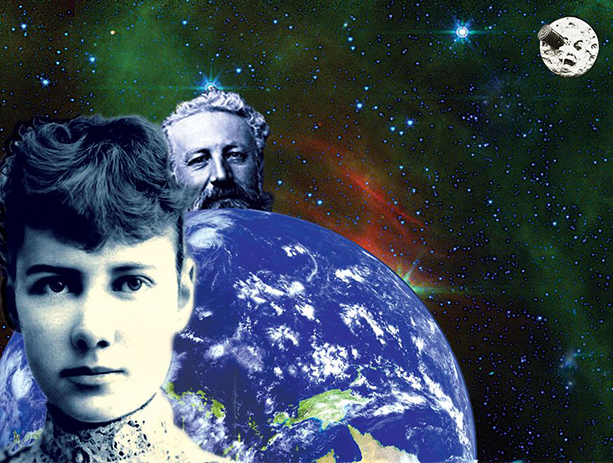He was, when I was growing up, a boy in a normative Middle American family, essential reading, along with Conan Doyle, Tolkien, and a few others. But I have the sense, hoping that I am wrong, that Jules Verne is not, at least in this country, so much read anymore. Part of this is simply because the culture has moved on and become more diverse, and that a certain kind of reading has become rarer. Librarians used to extol reading because it could take you to places you’d never been; it still can, but now we have the internet for that, at a click of the finger.
But in Verne’s case I suspect that it goes a little deeper, and to a specific event. The turning point may have been the Apollo moon landing in 1969, for it was then that the technological accomplishments of the 20th century most visibly outstripped those of his fictions. Verne’s lunar travelers didn’t succeed in landing on the moon, only encircling it and getting back to a Pacific splashdown, as previous Apollos had already done. It was as though, in a century of aircraft, submarines, polar expeditions, novel transport systems, and round-the-world travel, the last of his prophecies was moved beyond by one small step on that July day.
Verne was distinct from H.G. Wells, the other chief inventor of the sci-fi genre, in that he was a science fictionalist of the probable. Invisibility potions, men in the moon, time travel and alien invasions might not have been, strictly speaking, impossible, but Wells’ fancies exceeded any conceivable construction of known science or technology, then or now. Verne’s, on the other hand, were broadly consistent with existing knowledge, be it nautical, ballistic, aerodynamic, or optical. He was, after all, a Frenchman of the age spanned, in succession, by the Montgolfiers, Eiffel, and Méliès, and was the great celebrant of their spirit in popular literature.
Wells’ project was, of course, different than Verne’s. The irony in comparing the two is that the former’s portrayal of society, with its class distinctions and economic disparities, was naturalistically accurate, while Verne’s was naive and romantic, with a starry eyed faith in progress and the nature behind it. Wells used his unlikely science to expose the actuality of human relations. Verne’s plausible science served an idealistic, but somewhat dubious, view of goodness and human potential.
There is, for that reason, something touching and inspirational in Verne, and the Ensemble for the Romantic Century has sparked all these foregoing thoughts with an enrapturing project playing through Sunday at BAM Fisher. JULES VERNE: FROM THE EARTH TO THE MOON is an engineering feat in its own right, a smoothly functioning theatrical machine composed of French chamber music, historical docudrama, and multi-media projection. The prescient details of Verne’s fictional moon shot are intercut with the actual ones, along with selections from Méliès’ silent film and Offenbach’s operatic versions of the novels (there were two, which I recall reading together as From the Earth to the Moon and a Trip Around It.)
To all that is added the American journalist Nellie Bly‘s (successful) attempt to beat the fictional record set by the hero of Verne’s Around the World in Eighty Days, including time taken to call on the writer in France. Bly was a feminist pioneer who foresaw events in the social sphere with an uncanniness similar to Verne’s in the technological. His interactions with her adventure dramatize his notion of the United States as a can-do nation of technological ingenuity and democratic ideals, which was, I think, neither exactly wrong nor precisely right. The relative paucity of women in Verne’s fiction is alluded to, the upshot being that he was refreshingly honest in realizing the limitations of his ability to portray an experience that was not, socially or psychologically, his own. Verne’s novels are, in most other ways, remarkably inclusive, while at the same time naive about colonialism and the limits of American democracy.
Jonathan Hadary makes a solid, if rather stolid Verne, and, sporting the requisite beard, looks the part. Samantha Hill, as Bly, is a spry and lively presence, as both singer and actor. Honorine, Verne’s wife, is played by Jayne Atkinson with an attitude of affection and worldly wisdom. The musicians are co-equal to the actors: Sean Lee (violin), Andrew Gonzalex (viola), JiyoungLee (cello), Max Barros and Eve Wolf (piano), Joe Jung (banjo), and Rachel Kudo (cover pianist). Brian J. Gay, Andrew Howard, Matt MaGrath and Keaton Williams comprise a vocal quartet. The music is splendid to listen to, providing the aural equivalent to the romanticism of Verne’s – and Bly’s – visions. Songs by Stephen Foster, including his “Nellie Bly,” add a trans-Atlantic touch to the French composers, who include Chausson, Chaminade, and Gottschlalk, as well as Offenbach.
Eve Wolf wrote, Donald T. Sanders directed, and David Bengale did the extensive and often haunting video. JULES VERNE: FROM THE EARTH TO THE MOON is magical, even though it is grounded in science, journalism and historical documents. It is hard, in the end, not to have a soft spot for Romanticism, and this “theatrical concert,” so-called, hits it.
JULES VERNE: FROM THE EARTH TO THE MOON continues through April 12 at BAM Fisher. For tickets and information, click here.
